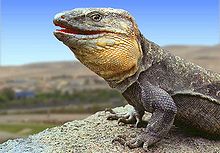Gran Canaria giant lizard
| Gran Canaria giant lizard | ||||||||||||
|---|---|---|---|---|---|---|---|---|---|---|---|---|

Gran Canaria Giant Lizard ( Gallotiastehlini ) |
||||||||||||
| Systematics | ||||||||||||
|
||||||||||||
| Scientific name | ||||||||||||
| Gallotia stalini | ||||||||||||
| ( Schenkel , 1901) |
The Gran Canaria giant lizard ( Gallotia dahlini ) is a species of lizard from the Lacertidae family . It was named by the Swiss zoologist Ehrenfried Schenkel in honor of Hans Georg Stehlin , who found the holotype .
features
The Gran Canaria giant lizard reaches a total length of more than 80 centimeters, making it the largest recent species within the genus Gallotia . The males reach a head-torso length of up to 26.5 centimeters, the females stay a little smaller with up to 20 centimeters. The head is massive. It is clearly set off from the narrower neck and looks triangular from above and below due to the distended cheeks. The basic color of the upper side is dark red or gray-brown in males and females. Many specimens have irregular and lighter colored stripes on the back and flanks. The color of the top of the head and the upper back are often very dark to black. In contrast, the throats and cheeks of adult animals are lighter and orange to flesh-colored. This coloring is particularly pronounced in males. The underside of the body is whitish-gray to flesh-colored and often darkly arched. On the throat there are often V-shaped drawings open to the rear.
The top of the body of young animals is olive brown. At the transition from the back to the flanks and along the lower flanks there are two white vertical stripes on each side. These can often be dissolved in spots. The underside of the body is whitish and has gray and V-shaped markings open to the rear on the throat.
Systematics
The species was first described as the subspecies Lacerta galloti va. Stuhllini by the Swiss zoologist Ehrenfried Schenkel at the Natural History Museum Basel in 1901. The holotype was collected by Hans Georg Stehlin on Gran Canaria .
No subspecies are distinguished.
Occurrence
The Gran Canaria giant lizard was originally only found on the Canary Island of Gran Canaria . In Fuerteventura it was introduced in two places, Puerto del Rosario and Barranco de la Torre .
In Gran Canaria it can be found from sea level up to 1900 meters. Almost all habitats that occur there are colonized. The species is only missing in the south of the island near Maspalomas in the vegetation-free dunes. In the interior of the island, it is less numerous in the forest-dominated areas. The animals are most common in anthropogenic habitats such as agricultural areas (e.g. with bananas or tomatoes), walls, piles of rubble and stones and landfills.
Way of life
While the species in the south of Gran Canaria is likely to be active all year round, in the north of the island and in the higher mountain regions during the cooler months, a significantly reduced activity can be observed. Here at least part of the population seems to be hibernating .
Females bury 4 to 16 eggs in June / July. These are 23 to 29 millimeters long and 14 to 18 millimeters wide.
The Gran Canaria giant lizard feeds on plant and animal food. Plants seem to predominate as food. The animals have a preference for sweet, overripe fruits and tomatoes, which is why they are considered pests by the local population and are followed accordingly. Predators are probably kestrel, common raven, buzzard and other birds, as well as domestic cats and house dogs.
The species has the loudest and deepest voice within the genus Gallotia . While young animals beep, adult animals make creaking noises. According to observations in captivity, the animals sometimes make terrifying noises when disturbed. Threatening gestures are also shown. With these, the head is raised, the bottom of the throat sacked down and the mouth is open. How wide the mouth is open determines the level of the sounds made. It is only light for high notes, but wide open for deep rumbling. In the open air, calls of the species could also be heard late in the evening.
supporting documents
- Dieter Glandt : Pocket dictionary of amphibians and reptiles in Europe. All types from the Canary Islands to the Urals. Quelle & Meyer, Wiebelsheim 2010, ISBN 978-3-494-01470-8 , pp. 361-363.
Web links
- Photos of the Gran Canaria giant lizard on www.herp.it
- Gallotia stehlini in the endangered Red List species the IUCN 2013.1. Posted by: Jose Antonio Mateo Miras, Valentin Pérez-Mellado, Iñigo Martínez-Solano, 2008. Retrieved September 23, 2013.
- Gallotiastehlini in The Reptile Database

